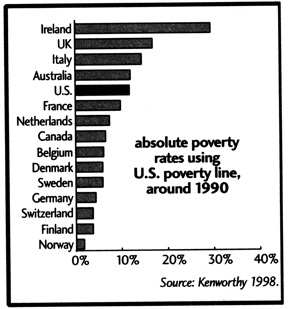Brett at Marstonalia writes, about the income charts I posted earlier:
Median income isn’t relevant for everything, of course — it would be nice to know what the median income is worth …
While I didn’t see an answer to Brett’s question, Henwood does provide a table showing poverty statistics in absolute, rather than relative measures (p135):

These are based on relative income measures, which is the practice of most LIS researchers. But how does the U.S. fare in terms of absolute measures? While we have a very high relative poverty rate, since average incomes in the U.S. are higher than in many European countries, maybe our poor are still better off than theirs.
Yes, in some cases, but surprisingly few. Shown on this page is an estimate of poverty rates using the equivalent of the U.S. poverty line in national currencies, not relative measures. Note that even though the U.S. has the highest average income of all countries shown, most have a smaller share of their populations below the U.S. poverty level than does the U.S. itself. The only exceptions are poorer countries like Ireland and Italy and other liberal countries like the UK and Australia …
Absolute measures are also important in evaluating a classic right-wing critique of welfare-state measures: if generosity results in lower growth than in stingier countries, the stingier countries might do better over the long term at raising the absolute incomes of their poor. But, as Lane Kenworthy (1998) shows, that’s not the case.
